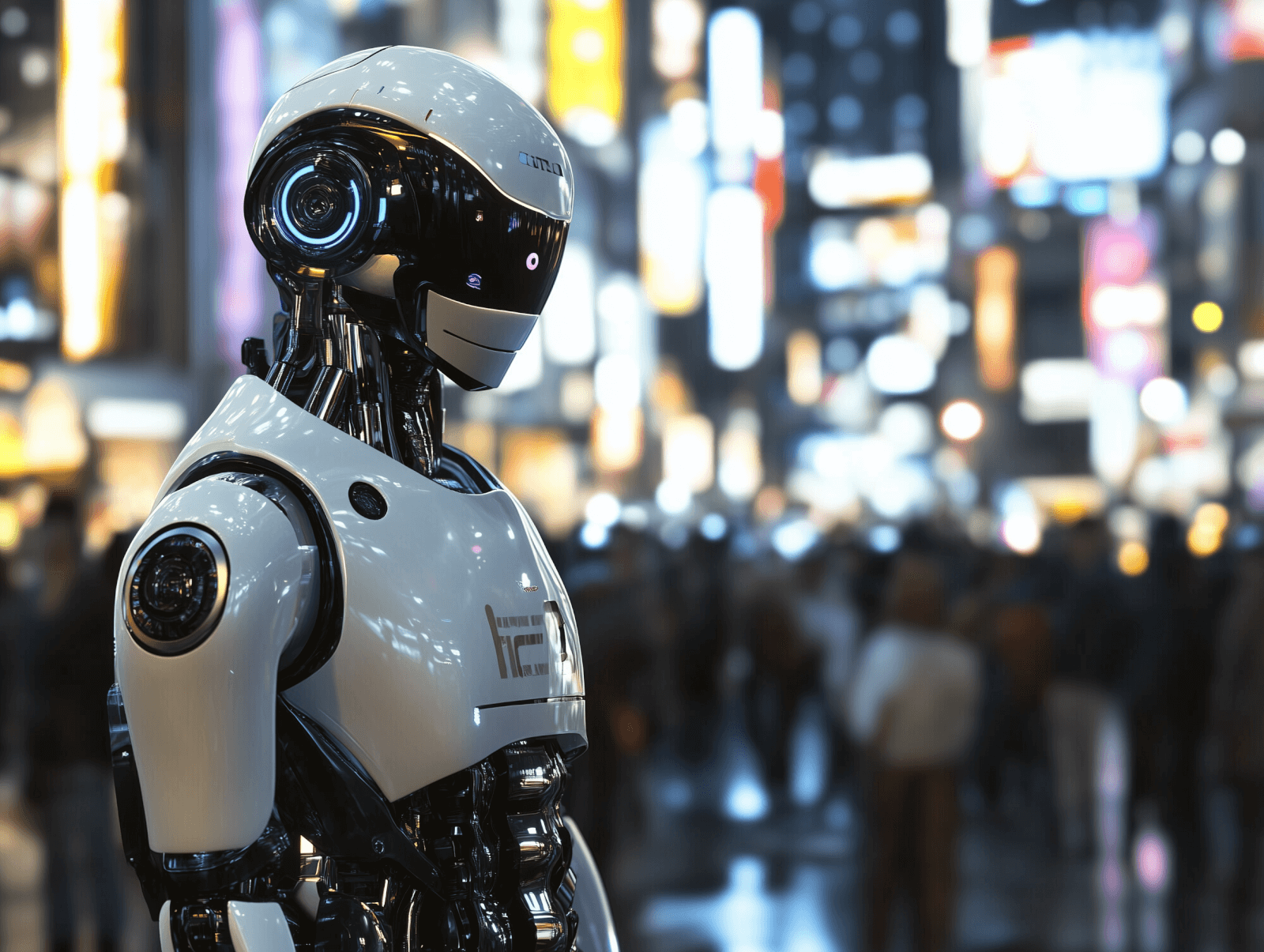Humanoid robots – once the stuff of science fiction – are rapidly becoming an impending reality in the global economy. Advances in artificial intelligence, engineering, and manufacturing are converging to bring life-sized, human-like machines out of the lab and into the workforce. Over the next two decades, this market is projected to explode from nascent stages to tens of billions – even trillions – of dollars in value. Tech giants and startups alike are racing to develop humanoids that can walk, lift, and learn, promising to transform industries and potentially usher in an era of unprecedented abundance for society. In this in-depth report, we’ll explore the emerging humanoid robotics sector – its market outlook, technological innovations, leading players, investment climate, societal implications, and the visionary future that experts foresee.
Market Overview: From Labor Shortages to Exponential Growth
An Answer to Demographic and Labor Pressures: A perfect storm of market conditions is driving interest in humanoid robots. Many countries face aging populations and labor shortages in key industries like healthcare, manufacturing, logistics, and domestic work. For example, Japan and China are experiencing a demographic crunch – Japan’s population over age 65 is on track to reach 35% by 2040, and China’s working-age population is shrinking fast. By 2050, China will have 366 million people over 65 (nearly 30% of its population). With fewer young workers and more elderly to care for, humanoid robots are seen as a critical solution to fill the labor gap. In the U.S., it’s projected that by 2030 about 25% of the population will be over age 70, creating huge demand for robotic assistants in healthcare and eldercare. At the same time, there are millions of unfilled jobs – as of late 2024, nearly 8 million U.S. jobs remained open, many in undesirable or physically taxing roles that humans are reluctant to take. Humanoid robots could both address worker shortages and take on the “dull, dirty, and dangerous” tasks in industries ranging from nursing to construction.
Poised for Exponential Growth: Thanks to these drivers, the humanoid robot market is poised for explosive growth. Conservative estimates from major research firms still predict a sizable industry: Goldman Sachs projects the global humanoid robot market could reach $38 billion by 2035, a more than six-fold increase from today. But some analysts foresee a far bigger future. Morgan Stanley’s longer-term outlook suggests humanoids could generate $1.6 trillion in annual revenue by 2040 and $11 trillion by 2050 in an upside scenario. And Cathie Wood’s ARK Invest published arguably the most bullish forecast: if humanoid robots achieve wide adoption “at scale” across households and industry, they envision a $10–$24 trillion total addressable market in the coming decades. To put that in perspective, $24 trillion is about a quarter of today’s global GDP – a massive new tech economy potentially in the making.
Such lofty projections also translate to sheer numbers of robots. Goldman Sachs estimates around 1.4 million humanoid units could be in service by 2035, while Morgan Stanley predicts 63 million humanoids in the U.S. alone by 2050 (impacting up to 75% of occupations in some way ). On the upper end, industry visionaries predict there could be billions of humanoid robots by 2040. Figure AI’s CEO Brett Adcock and Tesla’s Elon Musk have suggested anywhere from 1 billion to 10 billion humanoids worldwide by 2040 – numbers that would make these robots as common as cars or smartphones are today. In fact, Musk has argued humanoid robots will eventually be more ubiquitous than cars, calling them “10X more common than cars” in the future. Whether one takes the moderate or aggressive forecasts, the trajectory is clear: a huge new market is emerging.
Key Industries and Use Cases: Initial deployments of humanoid robots are focusing on industries with acute labor needs or where automation can greatly improve safety and efficiency. Manufacturing and warehousing are prime targets – humanoids can perform repetitive assembly tasks or move heavy goods in factories and fulfillment centers that struggle to hire enough staff. Logistics and shipping companies see value in robots that can load/unload materials and work 24/7 in distribution hubs. Eldercare and healthcare applications are also crucial; humanoid helpers could assist the elderly with daily activities, supplement an overstretched caregiving workforce, and support medical staff. In Japan, which leads the world in robot density (399 industrial robots per 10,000 workers as of 2022), humanoids are viewed as a remedy to a projected shortfall of hundreds of thousands of caregivers by 2040. Dangerous and outdoor jobs – such as disaster response, mining, and construction – are another arena, since humanoid robots can potentially go places and perform high-risk tasks humans shouldn’t, from nuclear cleanup to firefighting . Over time, as costs come down, we may even see humanoid robots in retail and food service (some companies are piloting robots for stocking shelves or flipping burgers) and household assistance as robotic “butlers” or maids. In short, any setting currently reliant on human labor, especially jobs that are dirty, dangerous, or in short supply of workers, is a candidate for humanoid automation.
Technological Innovation: AI Brains, Better Bodies, and Falling Costs
The accelerating progress in humanoid robots is not due to any single breakthrough, but rather a convergence of multiple technologies reaching maturity at once. Three key pillars underpin this revolution: advanced AI “brains,” improved hardware “bodies,” and rapidly declining costs of production. Added to this, a mindset of first-principles rethinking is helping engineers leap past old limits.
AI Advances – Giving Robots a Brain: The recent leaps in artificial intelligence, especially in multimodal and generative AI, are a major driver making humanoids far more capable. Modern AI models can now see, hear, speak, and make decisions in real time – essentially becoming the “brains” of humanoid robots. For instance, OpenAI’s latest GPT-4 model (a multimodal AI) can interpret visual inputs, understand spoken language, and generate text or actions. This means a humanoid robot equipped with such an AI could potentially recognize objects in its camera feed, carry on a conversation, and reason about how to solve a task. Today’s robots already leverage AI-based vision for tasks like picking and sorting objects, and use reinforcement learning algorithms to improve their performance with experience. As one Morgan Stanley report noted, “the growth in AI drastically increases the potential for humanoids to manage complex and nuanced scenarios… and also increases the robots’ ability to utilize more complex arrangements of sensors/vision/actuators needed to make humanoids commercially viable.” In short, smarter AI is unlocking the ability for robots to operate in unstructured, human-oriented environments (like homes or busy workplaces) that would have stumped the simpler robots of past decades.
Hardware Breakthroughs – A Better Body: Equally important are advances in the physical components – actuators, sensors, power systems – that make up a humanoid robot’s body. Building a machine with near-human mobility and dexterity is an enormous engineering challenge, but recent progress is closing the gap. High-torque electric actuators (the “muscles” of a robot) and new joint designs have enabled smoother, more powerful limb movements. Components like harmonic reducers, planetary roller screws, and coreless motors – once exotic technologies – are now commonly used in cutting-edge humanoid designs to achieve human-like motion control. Sensor tech has also leapt forward: today’s humanoids are fitted with arrays of cameras, lidar, ultrasound, and tactile sensors to perceive their environment in detail. A striking example is the evolution of LiDAR sensors (which give robots depth perception similar to 3D laser vision). A decade ago, a single LiDAR unit was the size of a coffee can and cost about $100,000 – far too bulky and expensive for a robot. Thanks to innovation driven largely by the self-driving car industry, modern LiDARs are now smaller than a deck of cards and cost around $1,000 (with a path to $500 soon). This 100-fold cost reduction and 1000-fold size reduction in a critical sensor illustrates the broader trend: components that once made humanoids impractical are becoming smaller, cheaper, and more capable year by year.
Battery and Power Improvements: Humanoid robots are also benefiting from the intense development of battery technology in the electric vehicle (EV) sector. Robots need dense, lightweight batteries to operate untethered for long periods. Fortunately, lithium-ion battery energy density has been improving at ~20% every two years (often dubbed “Moore’s Law for batteries”). According to Morgan Stanley, this pace could make solid-state batteries commercially available by around 2028–2030, a breakthrough that might dramatically extend humanoid robots’ operating hours . Already, most humanoid prototypes run 1–3 hours per charge, but higher-density batteries will push that further. There is also synergy in manufacturing: companies like Tesla are leveraging battery packs originally designed for EVs in their robots. The Tesla Optimus humanoid, for example, uses the same battery technology and supply chain as Tesla’s electric cars, which helps reduce development costs and ensure reliable production. In essence, the massive investments in EV batteries and power electronics are directly paying dividends for humanoid robotics.
First-Principles Thinking – Rethinking the Problem: Beyond incremental improvements, innovators are also going back to basics and applying first-principles thinking to redesign how robots are built and deployed. This means questioning every assumption and constraint from the ground up . One outcome of this approach is the idea of robots building robots. Today, one of the most expensive aspects of a humanoid robot is the human labor involved in assembling it. However, as the technology matures, companies envision highly automated factories (manned by robotic arms or even humanoid robots themselves) churning out new units. As one analysis put it, “in the out-years we will see humanoid robots building humanoid robots, which will reduce labor to near zero, enabling massive and rapid demonetization”. Another insight is that the “intelligence” cost – developing the AI software – can be spread across millions of units. Tech giants like Google, OpenAI, and Nvidia are pouring billions into AI research, creating extremely advanced models that can be deployed into robots at relatively low marginal cost . As a result, humanoid makers can piggyback on these AI metatrends instead of coding everything themselves. This effectively means each robot’s “brain” benefits from a global R&D effort, often for free or open-source, dramatically reducing the cost to imbue robots with intelligence.
First-principles thinking also pushes companies to set ambitious targets that force creative solutions. For instance, Tesla has publicly aimed for a future cost of $20,000 or less per humanoid unit – an order-of-magnitude drop from current costs . Achieving that will require streamlining every component and process, but it has spurred efforts toward ultra-simple designs, cheaper materials, and high-volume automated production.
Plummeting Costs and Economies of Scale: Indeed, one of the most encouraging trends for the market is how fast costs are coming down as design improves and scale ramps up. Just in the past year or so, some high-end humanoid prototypes have seen their build cost drop from about $250,000 to $150,000 – a 40% decrease that far outpaces the typical 15–20% annual cost decline seen in mature industries. As production moves from hand-built one-offs to assembly lines, we can expect further steep cost curves. A 2024 Morgan Stanley analysis estimated that currently, depending on configuration and use-case, building a humanoid robot could range from about $10,000 on the low end to $300,000 on the high end. In other words, some simple humanoids are already approaching automobile-like price points, while even the most advanced ones are getting out of the stratosphere of expense. Morgan Stanley went a step further by tearing down Tesla’s Optimus design to analyze its bill of materials. Their conclusion: Tesla’s Optimus Gen-2 has a parts cost of about $50–$60K per unit (excluding software) at present. The most expensive pieces were things like actuators in the legs (thighs and calves), advanced hands, and the waist/pelvis assembly – but none of those parts individually cost more than $9,500. This kind of analysis shows a pathway to mass-market robots. If today’s $50K BoM can be halved with scale and next-gen designs, and if software costs (which can be amortized over many units) are spread out, a sub-$20K selling price begins to look achievable in a few years. Ambitious targets like Tesla’s are motivating the whole industry to find creative ways to cut costs and “demonetize” robotics, much as we saw with personal computers and smartphones in past decades.
In summary, the technology needed to make useful humanoid robots – powerful AI brains, agile and efficient bodies, and affordable manufacturing – is finally coming together. This “perfect storm of innovation” is why so many companies and investors are piling into the space after years of humanoids being seen as impractical. We now turn to those companies leading the charge.
Leading Players: The Companies Building Our Robotic Future
A wide range of players, from Silicon Valley startups to automotive giants, are developing humanoid robots. Here we profile some of the key contenders driving the field forward, and how each is approaching the challenge:
Tesla – Optimus: The EV Maker’s Robot Workforce
It may surprise some, but Tesla – the electric car juggernaut – is at the forefront of humanoid robotics. Elon Musk unveiled the Tesla “Optimus” robot in 2021, and since then the company has rapidly developed at least two generations of prototypes. Optimus stands roughly human-sized (around 5 feet 8 inches tall) with a sleek black-and-white design that mirrors Tesla’s high-tech aesthetic. Under the hood, it leverages a ton of Tesla’s existing technology: the same self-driving computer and AI algorithms that power Tesla cars serve as Optimus’s “brain”, and its battery is adapted from Tesla’s EV battery modules. This gives Tesla a huge advantage in vertical integration – it can use its established supply chain and manufacturing expertise to build robots at scale.
Tesla’s vision for Optimus is grand. Musk has stated that Optimus could eventually be “more significant than Tesla’s vehicle business” and might become “the biggest product ever” made by Tesla. In the near term, the company is deploying Optimus units in its own car factories during 2024 to perform simple repetitive tasks, much like it tested early self-driving features on employee vehicles. Longer term, Tesla sees applications in both industrial and domestic settings. Musk has predicted an eventual consumer price of $20,000–$30,000 per robot, aiming to make it affordable enough to be as common as a car. To hit that target, Tesla is relying on massive scale production and continuing AI improvements to drive costs down. Notably, Tesla is not seeking outside AI partners – its AI development is entirely in-house (the same team that works on Autopilot and the Dojo supercomputer). This end-to-end control could yield tightly integrated robots but also puts pressure on Tesla to solve hard problems solo.
So far, Optimus prototypes have demonstrated basic walking, carrying items, and simple tool use. While still early, Tesla’s commitment of resources (the company’s market cap is over $1 trillion, giving it deep pockets ), combined with Musk’s relentless first-principles approach, make Tesla a top player to watch. As Musk boldly said, if humanoid robots succeed, “there is no meaningful limit to the size of the economy” they could create – a reflection of how Optimus fits into Tesla’s mission to push technological boundaries.
Figure AI – A Startup Betting Big on General-Purpose Robots
Among the startups, Figure AI has quickly emerged as a leader with outsized ambitions. Founded in 2022 by Brett Adcock (previously co-founder of Vettery and Archer Aviation), Figure has assembled a veteran team and attracted a war chest of funding to build a general-purpose humanoid. In 2023, they revealed Figure 01, a humanoid prototype, and by 2024 they were already testing Figure 02, a second-generation model about the size of an adult human (5 ft 6 in tall, 132 lbs). Clad in a sleek matte-black exterior, Figure 02 features 16 degrees of freedom in its hands and advanced coordination, earning it a 2024 innovation award in robotics.
What really sets Figure apart is its strong backing and partnerships. The company closed a huge Series B funding round of $675 million in 2024, which valued Figure AI at $2.6 billion. This round drew in a who’s-who of tech investors – Microsoft, OpenAI, Intel, NVIDIA, Jeff Bezos, and Cathie Wood’s ARK Invest all participated. Such support not only gives Figure ample capital, but also strategic allies: for example, Microsoft and OpenAI are working with Figure on AI and software, ensuring the robot’s “brain” stays cutting-edge. On the hardware side, Figure forged a partnership with BMW in manufacturing. In late 2023, a pilot program at BMW’s Spartanburg factory put Figure 02 units on the factory floor, where they successfully operated 24/7 for seven-day workweeks doing tasks like moving totes of components. After proving it could reliably handle warehouse logistics, Figure began permanent deployment of a fleet of its robots at that BMW plant in January 2024. This is a remarkable milestone – it makes Figure one of the first startups to have humanoid robots performing real work in a commercial factory environment.
Figure is initially focusing on manufacturing and warehouse jobs, but it hasn’t ruled out the home. The company has hinted at experiments in household tasks like kitchen work . Brett Adcock has also expressed a goal to eventually price the robots under $20,000, in line with competitors . Given the robust funding, Figure is hiring aggressively and aiming to iterate quickly. Adcock envisions deploying “3 to 5 billion” humanoid robots into the workforce if the technology evolves to do “everything a human can”. That statement underscores Figure’s mission: a broad-based, general robot for virtually any task – effectively an android assistant for society. While there is a long road between today’s prototypes and that vision, Figure AI’s blend of talent, capital, and early partnership traction positions it as a front-runner in the humanoid startup field.
Agility Robotics – Digit: From Warehouses to the Masses
Agility Robotics is a pioneer that has been working on legged robots for several years, and its humanoid Digit is poised to be one of the first mass-produced bipedal robots targeted at businesses. Agility spun out of Oregon State University in 2015 and initially built a two-legged robot called Cassie. Its latest model, Digit, adds arms and is roughly human-sized (5’9” tall, 143 lbs, with a 35 lb carrying capacity). Digit’s unique design includes springy, bird-like legs that allow it to crouch low or extend up high to grab objects – ideal for working in warehouses and distribution centers where shelf heights vary. The robot is optimized for “pick-and-place” tasks in logistics, like grabbing bins or packages and moving them, which are currently low-skilled, repetitive jobs done by people.
Agility has gained major strategic partners in the logistics realm. Notably, Amazon – the e-commerce giant with endless warehouses – has been involved with Agility, beginning to test a fleet of Digit robots at an R&D facility in Seattle as of October 2023. In another first-of-its-kind deployment, Agility partnered with GXO Logistics to put Digit into operation at a SPANX distribution facility in Georgia. There, Digit robots have been working under a Robots-as-a-Service (RaaS) model, meaning GXO essentially rents the robot’s labor – an approach that lowers the barrier for adoption. These deployments mark the industry’s first commercial implementation of humanoid robots in warehouse operations. Agility has also lined up support and service infrastructure; for example, Ricoh (better known for office equipment) is providing field support for Digits across North America.
To meet anticipated demand, Agility is making a big push into manufacturing. The company is constructing a dedicated robot factory called “RoboFab,” a 70,000 sq. ft. facility in Salem, Oregon. Scheduled to open in late 2024, RoboFab will have capacity to build 10,000 Digits per year – a huge leap from the handfuls of units Agility has built so far. Under the leadership of CEO Peggy Johnson (a former Microsoft executive who joined Agility), the plan is to deliver the first Digits to early customers by end of 2024 and open up general sales in 2025. At that output scale, Agility hopes to drive costs down and prove unit economics. They claim a return on investment (ROI) of under two years for businesses deploying Digit – meaning a robot would pay for itself in under 24 months by replacing human labor in certain roles. Digit is squarely aimed at filling the more than 1 million unfilled warehouse and logistics jobs in the U.S., a number that continues to grow. With strong investor confidence (Agility has raised over $180M from backers like DCVC and Playground Global, and even formed an alliance with Ford early on), the company is well-positioned. If RoboFab hits its stride, Agility Robotics could be the first to produce humanoids at automotive scales, making Digit a commonplace sight in warehouses later this decade.
Boston Dynamics – Atlas: Bleeding-Edge Tech, Paired with Caution
No discussion of humanoid robots is complete without Boston Dynamics, the company famous for viral videos of robots performing backflips and parkour. Boston Dynamics has been a robotics trailblazer for over 30 years (founded in 1992 as an MIT spin-off) and its bipedal robot Atlas represents the cutting edge of humanoid agility. Atlas is currently an R&D platform rather than a commercial product, but it showcases what the future might hold. The latest iteration of Atlas stands about 4’11” (150 cm) tall and weighs 196 lbs. Though stout, it’s incredibly powerful and dynamic – Atlas has demonstrated running, jumping between platforms, doing backflips, and even dancing in controlled demos. It has advanced three-fingered hands for manipulating objects and a full suite of sensors to maintain balance and perceive its surroundings.
Historically, Atlas was hydraulically actuated (hence the whirring sounds in older videos), but a recent milestone was converting Atlas to fully electric power in 2024, eliminating the noisy hydraulics and tethered power supply that earlier versions used. This transition to electric motors and batteries is key for any real-world deployment. Atlas’s control is enabled by Boston Dynamics’ cutting-edge software, and interestingly, the company is now incorporating AI advancements into the robot through partnerships. Toyota Research Institute (TRI) is collaborating with Boston Dynamics to integrate TRI’s Large Behavior Models (LBMs) – essentially big AI models for robot behavior – with Atlas’s hardware. This partnership aims to accelerate Atlas toward being a “true general-purpose humanoid” by combining BD’s unmatched hardware with Toyota’s AI prowess. In addition, Boston Dynamics has established its own independent AI Institute (with over $400M in funding from its parent Hyundai) to research next-gen robotic AI, ensuring it stays at the forefront of software as well as mechanics.
Commercialization is where Boston Dynamics has historically been cautious. The company was acquired by Hyundai Motor Group in 2021 for about $1.1 billion , giving it a strong corporate parent with automotive manufacturing expertise. Hyundai’s influence may be guiding Boston Dynamics to think more about practical products. The company has already successfully commercialized other robots: the Spot quadruped (a robotic “dog” used for inspections) and the Stretch robot (a wheeled machine for unloading trucks and moving boxes) are being sold to industrial customers. Leveraging that experience, Boston Dynamics is taking a “methodical approach” to bringing Atlas to market, prioritizing reliability and useful applications over speed . In essence, they don’t want to sell a humanoid until it can truly meet customer needs day in, day out. The likely initial use-cases for Atlas will be in industrial and commercial environments – perhaps construction tasks, warehouse work, or factory operations, where its agility and strength would be big assets. With Hyundai’s backing, when Atlas (or a successor humanoid design) is finally offered for sale, it will probably undergo rigorous testing akin to car prototypes. Boston Dynamics’ long track record means they won’t rush an immature product. But make no mistake: Atlas’s capabilities are years ahead of most competitors, and if the company can reduce costs and improve battery life, it could set the gold standard for what humanoid robots can do in the real world.
Unitree Robotics – Affordable Humanoids from China
While many Western companies chase humanoid robots, China is also a hotbed of robotics innovation. Unitree Robotics, based in Shenzhen, has quickly made a name for itself by focusing on affordable, mass-produced robots. They first gained attention for making quadruped robots (akin to Boston Dynamics’ Spot) at a fraction of the cost. Now Unitree has unveiled not one but two humanoid robot models: the larger H1 and the smaller G1 . The H1 is a full-size humanoid about 5’11” (180 cm) tall and 104 lbs (47 kg), with a hefty payload capacity of up to 66 lbs (30 kg). The G1, by contrast, is a compact humanoid at 4’2” (127 cm) tall and 77 lbs (35 kg) in weight. The G1’s load capacity is smaller (around 7 lbs), reflecting its role as more of a research and education platform.
Despite being late to the humanoid race, Unitree has revolutionized pricing. The H1 is priced around $90,000 as a high-end industrial model, while G1 has a startlingly low starting price of $16,000. For context, $16K is about 1/5th the cost of some competitors’ prototypes, putting G1 in the range that universities, labs, and even hobbyists could consider. How can Unitree go so low? A big reason is their focus on vertical integration and in-house manufacturing. Much like how Chinese firms disrupted the drone market with cheaper production, Unitree builds many components themselves and at volume. They also incorporate off-the-shelf tech where possible: notably, Unitree partnered with NVIDIA to use the NVIDIA Orin AI controller in the G1 (Education version) . This gives the robot solid AI processing power out-of-the-box for vision and autonomy, without Unitree having to develop all the computing hardware from scratch. The H1 and G1 both feature a suite of sensors expected in modern humanoids – 3D LiDAR for mapping, Intel RealSense depth cameras for vision, and microphone arrays for audio. Unitree has impressively demonstrated these models with untethered walking at trade shows like CES 2024 and NVIDIA GTC, where they showed off balancing and locomotion.
The company’s strategy is to make advanced robotics accessible through aggressive pricing . Both H1 and G1 are already available for purchase (targeting research institutes, universities, and companies that want to experiment). By seeding the market with lower-cost units, Unitree could build a large user base and data pool, which in turn helps improve their robots. It’s a playbook similar to DJI in drones or certain electric car makers in China who undercut on price to gain scale. For now, Unitree’s humanoids are likely less advanced in software and dexterity compared to, say, Boston Dynamics or Tesla’s prototypes. But their head start in commercialization and cost efficiency is significant. If H1 and G1 continue to improve, Unitree may well capture a sizable chunk of the market, particularly in Asia and among cost-sensitive buyers. The presence of NVIDIA as an AI partner also signals credibility. In a space often characterized by expensive R&D projects, Unitree is a reminder that humanoid robots could also follow a consumer electronics-like trajectory of rapid cost reduction.
Apptronik – Apollo: Versatile Robots via NASA Know-How
Austin-based Apptronik is another rising startup that merits attention. Spun out of the University of Texas Human Centered Robotics Lab in 2016, Apptronik cut its teeth developing robotics for NASA (they helped build NASA’s Valkyrie humanoid). Now they’ve applied that expertise to their own commercial humanoid named Apollo. Apollo is designed as a versatile, human-safe robot for various environments. It stands 5’8” (172 cm) tall and weighs 160 lbs (72.5 kg), with the ability to lift about 55 lbs (25 kg) payload. Apptronik emphasizes Apollo’s custom linear actuators that mimic human muscles for smoother, compliant movements. This is important for working alongside people – Apollo’s actuators and advanced safety systems allow for direct physical collaboration without hurting humans. The robot also integrates tightly with AI software: Apptronik uses NVIDIA’s AI platforms (e.g. Project Groove) to train Apollo’s behaviors, and Apollo will rely on NVIDIA’s foundation models for robotic learning to continuously gain skills.
Apptronik has secured some notable partnerships to validate Apollo. The company is working with Mercedes-Benz on a proof-of-concept for using Apollo in automotive manufacturing. Tasks likely include moving materials or performing repetitive assembly-line jobs. In the logistics sector, Apptronik partnered with GXO Logistics (the same 3PL working with Agility’s Digit) to test Apollo in warehouse automation . Demonstrating versatility, these partnerships show Apollo can be applied in both factory and warehouse settings – two quite different environments. And of course, Apptronik’s early link to NASA remains a pedigree; the company has heritage in building robots to NASA’s strict specifications, which bodes well for engineering rigor.
While Apptronik has been quieter about its funding than Figure or Agility, it reportedly reached a valuation around $1 billion after investment from clients and VC backers. The CEO, Jeff Cardenas, has indicated that Apptronik’s approach is to create a general-purpose platform in Apollo that can be adapted to many tasks rather than a single dedicated use. Right now, the company is in the phase of conducting pilot programs (as mentioned with Mercedes and GXO). The feedback from these will shape Apollo’s final design before a wider release. Apptronik’s Texas location and talent (many from UT Austin) give it a strong robotics cluster to draw from, and the NASA connection lends it credibility in both government and industry circles. If Apollo proves itself in these trials – showing it can reliably do strenuous, “boring” jobs in big industries – Apptronik could become a key supplier of humanoids to companies looking to automate physically demanding tasks.
Sanctuary AI – Phoenix: Pushing the Bounds of Robot Intelligence
Canada’s Sanctuary AI is taking a slightly different tack in the humanoid race, with an emphasis on general intelligence and dexterity. Founded in 2018 in Vancouver, Sanctuary’s core belief is that true usefulness comes from a robot that can understand and adapt to a wide variety of tasks. Their humanoid, called Phoenix, is now in its seventh generation – a testament to rapid iteration. Phoenix is 5’7” (170 cm) tall and weighs 155 lbs (70 kg), with a capability to lift about 55 lbs (25 kg), placing it among the stronger robots of its class. But Sanctuary’s standout feature is Phoenix’s hands and control software. The robot boasts extremely advanced dexterity, with improvements focused on the wrists, hands and fingers to achieve fine motor skills. In mid-2023, Sanctuary claimed a world record by having a previous-gen robot (Phoenix’s predecessor) autonomously perform over 110 different hand-over-hand tasks in a standard work environment.
Sanctuary’s secret sauce is its AI control system, dubbed “Carbon”, which allows the robot to learn new tasks in as little as 24 hours. This is a dramatic improvement from earlier approaches that required weeks of programming for each new task. Essentially, Carbon combines machine learning and perhaps some teleoperation to quickly teach Phoenix what needs to be done, which then the robot can replicate on its own. The company proved this out in a real-world trial: they partnered with a Canadian retail chain and deployed Phoenix in a Mark’s clothing store in British Columbia, where the robot was able to successfully complete 110 distinct tasks (such as stocking shelves, cleaning, packing products, etc.) during its assignment. This kind of broad capability in a retail setting is a significant validation of Sanctuary’s approach to versatility.
On the commercial front, Sanctuary AI has struck a major partnership with Magna International, one of the world’s largest auto parts manufacturers. Magna not only plans to deploy Phoenix robots in its automotive factories, but is also serving as a contract manufacturer to help Sanctuary build future units. This deal is huge for Sanctuary: Magna’s involvement provides manufacturing muscle (they can scale up production and source components efficiently) and also a direct customer for robots in industrial settings. With Magna’s global presence, if Phoenix excels in Magna’s plants, it could open doors to many other clients. Sanctuary’s focus areas thus seem to be retail and manufacturing at first, leveraging Phoenix’s dexterity for both shelf organization and assembly tasks.
In terms of company status, Sanctuary AI remains privately held with an undisclosed valuation, but it has raised funding from prominent tech investors in Canada and the U.S., and its interim CEO James Wells leads a growing team of AI researchers and engineers. They also list NVIDIA as an AI partner, indicating they utilize NVIDIA hardware/AI solutions for Phoenix. Sanctuary’s long-term vision aligns with the loftiest in the field: they talk about “general purpose robots” that can do virtually anything a human can. Their approach of rapidly training robots on real tasks and focusing on hand functionality addresses one of the hardest challenges (manipulation). If they continue at this pace, Sanctuary AI could be a dark-horse that delivers a truly multi-talented humanoid ready to hire for many different jobs.
1X Technologies – NEO: A Humanoid for the Home
Among the up-and-comers, 1X Technologies (formerly Halodi Robotics) is notable for explicitly targeting home and everyday environments with its humanoid design. 1X is a Norwegian/American company founded in 2014, and unlike others, it started with a very practical robot: a wheeled humanoid called EVE. EVE has already been deployed (around 150–250 units) through a partnership with ADT Commercial’s Everon security division, patrolling buildings as a robotic security guard . Building on that experience, 1X is now developing NEO, a bipedal humanoid meant to operate in homes and offices. NEO is human-sized at 5’5” (165 cm) but notably lightweight at just 66 lbs (30 kg). Its payload capacity is around 44 lbs (20 kg), enough for carrying household objects or tools.
NEO’s design emphasizes natural human interaction and integration. It’s equipped with advanced sensors for perceiving people’s emotions and has AI for understanding human speech and behavior cues. The idea is a robot that could, say, recognize if an elderly resident has fallen or if someone is upset, and respond appropriately. 1X is leveraging a “groundbreaking generative model” trained on extensive real-world robot data to improve NEO’s decision-making. This approach, aiming to close the “sim-to-real gap,” benefits from the thousands of hours of operational data they gathered with their earlier EVE robots in security roles.
Strategically, 1X has powerful backers. It received funding from the OpenAI Startup Fund, as well as venture capital from Tiger Global and EQT Ventures . OpenAI’s involvement is particularly intriguing – it suggests a close connection to cutting-edge AI that could be integrated into NEO’s control systems. The company’s valuation is reported around $375 million as of 2024, and they relocated significant operations to California, indicating a push into the U.S. market. 1X’s timeline is highly ambitious: they have deployment targets of thousands of NEO units by 2025 and potentially millions by 2028. Those figures sound optimistic, but they reflect the company’s focus on the consumer/home side – a market that indeed has the potential for millions of units if a killer app robot is realized.
If NEO can navigate a home, interface with smart home systems, and help with daily tasks (think cooking prep, cleaning, fetching items, eldercare monitoring), it could unlock a huge demand from households, especially as the population ages. Of course, cracking the consumer robot market has historically been difficult (just ask any home robot vacuum maker or the defunct Jibo social robot). But 1X’s strategy to start with commercial security deployments (revenue-generating, learning from real use) then move to home robots is savvy. With OpenAI and NVIDIA as AI partners , NEO will likely be on the forefront of integrating state-of-the-art AI into a friendly, domestic humanoid. Time will tell if they can hit their aggressive scale goals, but 1X is certainly a startup to watch, especially for those interested in having a personal robot in the home one day.
Investment Climate: Big Bets on Bots and a New Tech Ecosystem
Where big opportunity beckons, big investment follows – and the humanoid robotics sector is no exception. In the past two years, we’ve seen surging venture capital and corporate investment into humanoid robot companies, reminiscent of the early days of the personal computer or internet booms. This influx of funding is enabling rapid progress and is also giving rise to an ecosystem of suppliers and partners around the humanoid trend.
One of the headline-grabbing deals was Figure AI’s aforementioned $675 million funding round at a $2.6 billion valuation in 2024. The roster of investors involved reads like a tech Hall of Fame – it included Jeff Bezos, Microsoft, OpenAI, NVIDIA, Intel, and ARK Invest’s Cathie Wood. Such a coalition underscores the broad belief in the humanoid opportunity: software giants (Microsoft, OpenAI) want to provide the “brains,” chipmakers (NVIDIA, Intel) see a new market for processors, and visionary financiers (Bezos, Wood) are betting on long-term societal impact. Similarly, 1X Technologies attracted funding from OpenAI and Tiger Global, and Agility Robotics’ earlier rounds involved the likes of Amazon. Even Tesla’s humanoid effort, though internally funded, benefits from Tesla’s tremendous market capitalization (investors in Tesla are indirectly funding Optimus development as part of the company’s R&D).
Traditional venture capital is not alone – industry players are also making strategic investments and partnerships. For example, Hyundai bought Boston Dynamics, as noted, to integrate robotics into its portfolio of mobility solutions. Magna’s partnership with Sanctuary AI likely came with an investment component, tying a manufacturing giant to a robot startup. From Asia, we see companies like Toyota (via TRI) and Honda (with its legacy ASIMO program) also putting money into humanoid R&D. Chinese tech companies and manufacturers (such as Xiaomi and Xpeng, which are developing their own robots) are fueled by substantial domestic investment and government support, as China views robotics as a strategic industry.
Wall Street has taken notice too. In 2023, Morgan Stanley published a comprehensive “Bluepaper” report titled “Humanoids: Investment Implications of Embodied AI.” In it, Morgan Stanley analysts not only sized the market (as discussed earlier) but also compiled what they call the “Humanoid 66” – a list of 66 publicly traded stocks poised to benefit from the rise of humanoid robots. This list spans three categories:
- Enablers: companies that develop humanoid robots or supply key components (the “brains and bodies” of robots). This includes obvious players like robot manufacturers and parts suppliers.
- Beneficiaries: companies that could deploy humanoid robots to enhance their business or improve productivity, thus benefiting from humanoid labor.
- Enablers & Beneficiaries: a hybrid category for companies that both build robotic tech and will use it themselves.
Figure: Morgan Stanley’s “Humanoid 66” highlights the broad range of companies set to gain from humanoid robotics. Enablers (blue) include robot developers, component suppliers (sensors, batteries, semiconductors, software), while Beneficiaries (orange) span industries from transportation and e-commerce to construction and retail that could utilize humanoid labor. Some, like auto OEMs, are both enablers and beneficiaries.
The Enablers group in the Humanoid 66 encompasses many high-tech manufacturers – for example, makers of robotic arms, actuators, and gears (companies like Harmonic Drive and Nabtesco in Japan, or Siemens which makes factory automation systems). It also includes battery producers (CATL, LG Energy Solution) and chip makers (NVIDIA, AMD, Qualcomm) that will provide the electronics and power for these robots. On the software side, firms like Alphabet (Google) and Unity are listed, reflecting their roles in AI development and simulation software for robots. The Beneficiaries category ranges surprisingly wide: it lists companies in transportation and shipping (e.g. DHL, FedEx), e-commerce and retail (Amazon, Alibaba, JD.com, Walmart), automotive manufacturing (Toyota, Tesla, Stellantis), oil & gas (Schlumberger, Halliburton), construction (Caterpillar, Ashtead), and even restaurants/fast food (e.g. McDonald’s, Yum! Brands) . The thinking is that humanoid robots could eventually work in all these arenas – from delivering packages to flipping burgers – so companies in those sectors stand to gain via productivity boosts. Notably, some automakers like Tesla and Toyota appear as both Enablers and Beneficiaries, since they are building robots and will use them in their own factories.
The creation of a stock index for humanoid robots, so to speak, is a telling sign of how seriously mainstream investors are taking this trend. It parallels how investors tracked the rise of PCs, the internet, or more recently AI and electric vehicles, by identifying the cluster of companies involved. Morgan Stanley’s analysts pointed out a “stronger commitment from the supply chain [and] multiple listed players setting up new robot divisions” as evidence that the investment climate around humanoids is heating up. Indeed, in the past year we’ve seen companies like Dyson announce plans for home robots, Xiaomi unveiling a humanoid prototype, and numerous AI software startups pivoting to robotics.
All this money flowing in means humanoid robotics companies can hire top talent, invest in long-term research, and scale up manufacturing when ready. It’s creating a positive feedback loop: as more breakthroughs happen and prototypes improve, investor confidence increases and more capital is injected, which in turn funds further advancements. There is also a sense of competition on the global stage. The U.S. and Asia (especially China and Japan) are each investing heavily in robotics to ensure they aren’t left behind, and governments are introducing policies to support automation given the demographic challenges. For investors today, there are opportunities not only in the robot makers themselves but across the ecosystem – from sensor suppliers to AI software providers and end-user adopters. As the Humanoid 66 list suggests, the ripple effects of this revolution could touch many parts of the economy.
Societal Implications: Jobs, Ethics, and Life with Robot Colleagues
The rise of humanoid robots brings not just technical or financial considerations, but profound societal questions. After all, if robots are to work among us and even in our homes, we must grapple with how that changes our lives, our work, and our social structures. There are both exciting opportunities and serious challenges on the horizon.
Labor Market Disruption vs. Alleviating Shortages: Perhaps the biggest debate is around jobs. On one hand, humanoid robots can fill roles where there are not enough people or where the work is undesirable. As noted, sectors like eldercare and warehouse logistics are currently experiencing severe labor shortages . In these cases, robots could be a saving grace – taking on tasks that no one is being displaced from because positions are going unfilled anyway. Humanoids could also enhance human workers’ jobs: think nurses supported by a robot that lifts patients, or technicians using a robot helper to fetch tools and parts. This augmentation could reduce workplace injuries and burnout, and boost productivity.
On the other hand, there is a genuine concern that widespread robotic automation could displace many workers in the long run. Humanoid robots, by design, can potentially do anything a human can do physically. If their intelligence and reliability reach a certain threshold, they might compete with human labor across a huge swath of jobs – from factory assemblers and cleaners to even service jobs like chefs or retail clerks. The speed at which AI and humanoid development is progressing, “paired with the lack of public discourse on this subject,” indicates that society could be caught off guard by the scale of disruption. A Morgan Stanley analysis warned that by 2050, up to 40% of employees and 75% of occupations could be affected in some way by humanoid robots entering the workforce .
Universal Basic Income and New Social Contracts: To address potential job displacement, ideas like Universal Basic Income (UBI) are gaining renewed attention. If robots eventually do take over a significant portion of current jobs, how do humans earn a living? UBI proposes that governments or businesses provide a baseline income to all individuals to cover their needs, decoupling survival from employment. Some experts argue that heavy automation makes UBI practically necessary. In fact, even today tech leaders have floated the idea of a “robot tax” – taxing companies that utilize robots and AI in place of human workers to fund social safety nets like UBI. This concept has been mentioned as one way to redistribute the enormous productivity gains that automation could deliver, ensuring people still have spending power and quality of life even if traditional jobs become scarce .
Policies and pilot programs to test UBI have popped up in various countries, and the humanoid revolution might accelerate their consideration. At the same time, education and job retraining programs will be crucial. Historically, each industrial revolution created new kinds of jobs even as it made others obsolete. The optimists believe humanoid robots will take over menial tasks but open up new opportunities in robot maintenance, supervision, AI training, and entirely new industries we can’t yet imagine. The challenge is managing the transition period and ensuring those displaced can find roles in the new economy.
Ethical and Safety Considerations: Beyond economics, there are ethical questions about integrating humanoids into daily life. One issue is ensuring robots are safe and behave ethically themselves. They will be entrusted to care for vulnerable people (children, elderly), to operate in public spaces, and possibly to make split-second decisions that could impact human safety. Rigorous testing, robust AI control (with failsafes), and possibly regulatory standards will be needed to prevent accidents. For instance, how do we certify that a humanoid can drive a forklift in a warehouse without injuring anyone, or that a home assistant robot won’t accidentally harm the person it’s supposed to help out of bed? Organizations like UL are already looking at safety standards for service robots. There’s also the matter of privacy – a humanoid in the home likely has cameras and microphones active, raising concerns about data it might capture or transmit. Users will need assurances that their robot butler isn’t spying on them or leaking information (a parallel to smart speaker privacy issues, but potentially more intense given a robot can physically roam your home).
Another ethical aspect is how we humans treat the robots. While robots do not have feelings (yet) and are tools, people may anthropomorphize them, especially humanoids that look or act human-like. This could lead to new forms of attachment or, conversely, abuse. It’s conceivable that society will need guidelines for the humane treatment of robots, not because the robots “feel” but because mistreating humanoids could have psychological spillover on how humans treat each other. Already, we saw this conversation with Amazon’s warehouse robots and delivery drones – and humanoids will amplify it. Some have even speculated about future rights for robots if they become advanced enough, though that’s a very theoretical debate at this stage.
Changing Daily Life and Social Interactions: In more practical terms, having robots among us will change daily life much like smartphones and the internet did. Workplaces might evolve into mixed human-robot teams. It wouldn’t be unusual to have a robot colleague at a factory workstation or a robot security guard patrolling an office building at night. Companies will develop training for employees on how to work alongside robots – for example, understanding a robot’s signals or knowing when to intervene if it gets stuck. Homes could likewise see robots as part of the family unit. An elderly person living alone might rely on a humanoid for assistance with everything from dressing to remembering to take medication. Families might have a robot do housekeeping chores or even babysit kids in limited ways (like monitoring for safety). This raises questions: Will people become too dependent on machines? How does it affect human-to-human interaction if some social needs are filled by robots? These are questions psychologists and sociologists have begun exploring.
On the positive side, many see humanoid robots as a path to greatly improved quality of life. Imagine a future where mundane chores are offloaded to your robot helper, freeing your time for family, hobbies, or creative pursuits. In eldercare, robots could enable seniors to live independently longer by handling physical tasks and providing companionship – addressing the eldercare crisis where human caregivers are too few to meet the need. In hazardous jobs, sending a robot instead of a human could save lives (for example, in a chemical plant emergency or mining accident). There’s even the aspect of sheer innovation appeal: much as personal cars and phones became part of our lifestyle, advanced personal robots could be the next aspirational gadget, improving convenience and capabilities in everyday life.
Public Discourse and Preparation: A notable point is that broad public discussion about these changes is only just beginning. The technology is advancing fast, and it often takes society time to catch up in conversation and policy. Observers have pointed out the need for dialogues involving technologists, policymakers, ethicists, and the public to shape how we want humanoid robots to fit into our world. This could include updating labor laws (e.g., can a robot legally perform a certain task unsupervised?), adjusting education systems (training more robotics engineers and AI specialists, but also teaching new skills to those in at-risk jobs), and setting norms (like maybe robots should always identify themselves as robots in interactions, to avoid confusion or deception).
In summary, the societal implications of humanoid robots are vast. They hold the promise of alleviating drudgery and addressing serious demographic challenges, potentially leading to a world of greater material plenty. But they also pose disruption risks and ethical dilemmas that society will need to navigate carefully. We stand at the cusp of a transformation in the nature of work and daily life – one that will require as much social innovation as technological innovation.
Vision of the Future: Toward a World of Abundance
What might the world look like in a few decades if humanoid robots become as integrated into society as cars or computers are today? Many of the leaders in this field paint an ambitious, even utopian picture of the future – one where robots help unlock an era of abundance and prosperity that vastly exceeds anything before.
Elon Musk frequently speaks about the profound implications of AI and robotics. Regarding Tesla’s Optimus and similar humanoids, Musk says “this means a future of abundance, a future where there is no poverty”, a world where “you can have whatever you want in terms of products and services”. In his view, if labor and manufacturing capacity become almost limitless thanks to robots, the cost of goods will plummet and wealth could be distributed to ensure no one is left lacking. Musk likens it to a fundamental transformation of civilization – essentially a post-scarcity society where starvation, hard manual toil, and material need are consigned to history.
Brett Adcock of Figure AI echoes this optimism. He imagines a future where the prices of goods and services trend toward zero and GDP “spikes to infinity” as robot labor exponentially scales productivity . In other words, robots could produce so much value so cheaply that, in theory, economic output is limited only by resources and imagination, not by human labor constraints. Adcock suggests “you basically can request anything you would want and it would be relatively affordable for everybody in the world”. It’s a bold vision – essentially the Star Trek-like economy where automated production can meet everyone’s needs.
NVIDIA’s CEO Jensen Huang has also weighed in with dramatic forecasts. Huang predicts that by 2040 there could be a billion bipedal robots in the world, performing a wide range of jobs . He frames it in terms of human liberation: robots would be “freeing humans from the slavery of the bottom 50% of really undesirable jobs” . Tasks like assembly line work, heavy lifting, cleaning – all those could be handled by machines, allowing people to pursue more creative, strategic, or personally fulfilling work. In Huang’s view, robots are an extension of AI’s potential to elevate humanity by taking over the drudgery.
Of course, there are voices of caution alongside the optimism. Some futurists worry about how society will adapt and whether that abundance will be equitably shared. But even skeptics generally agree that if managed well, humanoid robots could drastically increase global standards of living. Imagine affordable robotic helpers contributing in every hospital, every farm, every small business. Regions with aging populations could maintain productivity; emerging economies could industrialize faster with robotic labor; remote areas could receive goods and services via robotic supply chains. It could be a future where GDP is no longer bottlenecked by human labor availability – what economists call “labor constraints” would essentially dissolve in sectors where robots operate. That implies potentially astronomical economic growth or the redirection of human effort to new frontiers (art, science, exploration, caring professions, etc.).
This future might also transform our conception of work. If robots handle most necessities, humans might work by choice rather than necessity, focusing on creative endeavors or social contributions. The idea of a four-day work week or shorter could become feasible when robot coworkers double productivity for the same hours. Education might shift to emphasize uniquely human skills – creativity, critical thinking, interpersonal skills – while rote technical tasks become less important to learn.
It’s worth noting that such a robot-abundant world also needs energy and resources to run, so parallel advances in sustainable energy and resource extraction will matter. But many of those trends (like solar power growth, advanced recycling, even asteroid mining in the far future) are moving in a positive direction. Humanoid robots could themselves assist in green transitions (imagine robots building renewable infrastructure faster, or performing environmental cleanup tasks).
Ultimately, the vision of the future is one where humanoid robots are as commonplace and transformative as computers or smartphones have been – perhaps even more so. We could see a robot in every home, every business, and a few even on every street corner. Production and services might become so cheap that basic needs are met universally, potentially eradicating poverty. Society will likely have had to reinvent its economic models (with mechanisms like UBI or other forms of distribution) to handle the wealth generated by robots. Culturally, we may come to accept robots as a new class of “being” in our daily interactions – not human, but not your ordinary machine either; something in between that we work with and rely on.
Is this techno-optimist vision guaranteed? Not at all – it hinges on solving technical challenges, managing ethical pitfalls, and making wise policy choices. There are dystopian possibilities too (e.g. misuses of robots in warfare or oppression, or severe inequality if only a few own the robots). But with conscientious development, the humanoid robot revolution could indeed herald a “future of abundance” unlike anything we’ve experienced. As Peter Diamandis – an advocate of exponential technologies – wrote in the MetaTrend report introduction, we should prepare for “a future of Abundance (and an abundance of robots)” .
For now, the seeds of that future are being planted in labs and startups around the world. The next decade will reveal how fast we can grow those seeds into reality. If the momentum holds, we may one day look back on the 2020s as the dawn of the age of humanoid robots – when our tools finally took human shape and opened the door to a new chapter of human progress.
Sources: The information and quotes in this report are based on data from the MetaTrend Humanoid Robots report (2024), along with research insights from Goldman Sachs, Morgan Stanley, ARK Invest, and various company releases as cited throughout. This reflects the state of robotics as of late 2024, a moment when science fiction ambitions are fast becoming science fact.













